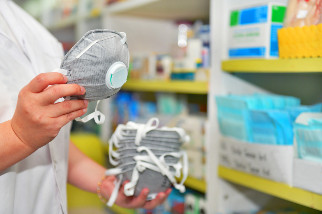As the COVID-19 pandemic spreads across the country, it is critical for employers to have the tools they need to protect their workers’ health. The shortage of N95 respirators during this outbreak has put a strain on healthcare providers and others to provide respiratory protection to workers.
it is critical for employers to have the tools they need to protect their workers’ health. The shortage of N95 respirators during this outbreak has put a strain on healthcare providers and others to provide respiratory protection to workers.
In response to a call from President Trump, the Department of Labor is taking steps to increase the availability of general use respirators for emergency use by healthcare personnel in healthcare facilities. OSHA has issued temporary guidance for its respiratory protection standard, 29 CFR 1910.134, regarding required annual fit-testing of general use respirators.
UPDATE - April 8, 2020: OSHA has expanded this guidance to include all industries during the COVID-19 pandemic. The guidance now applies to all workplaces covered by OSHA where there is required use of respirators.OSHA field offices will exercise enforcement discretion concerning the annual fit-testing requirements, as long as employers have made good-faith efforts to comply with the requirements of the Respiratory Protection standard and to follow the steps outlined in the March 14, 2020 memorandum for healthcare facilities.
This expanded guidance encourages employers to assess work practices, administrative controls and engineering controls to identify any adjustments that can be made to decrease the need for N95s or other FFRs. In addition, employers should prioritize use of fit-testing to protect employees who must use respirators for high-hazard procedures.
29 CFR 1910.134 requires that employers provide and ensure proper use of respiratory protection when necessary to protect worker health. Requirements within the standard include a written program, medical evaluation, training and fit-testing. OSHA encourages healthcare providers to use CDC guidelines for conserving their respirator supply, while continuing to safeguard workers. This includes providing respirators of equal or higher protection to an N95, such as N99 or N100 filtering facepieces, and to use non-destructive methods for fit-testing. Appendix A of 29 CFR 1910.134 offers qualitative and quantitative fit-testing methods for filtering facepiece respirators to help ensure that they fit properly.
OSHA’s March 14, 2020 memorandum notes that “OSHA field offices shall exercise enforcement discretion concerning the annual fit testing requirement, 29 CFR 1910.134(f)(2), as long as employers:
- Make a good-faith effort to comply with 29 CFR 1910.134.
- Use only NIOSH-certified respirators.
- Implement CDC and OSHA strategies for optimizing the supply of N95 filtering facepiece respirators and prioritizing their use.
- Perform initial fit tests for each health care provider with the same model, style and size respirator that the worker will be required to wear for protection against COVID-19 (initial fit testing is essential to determine if the respirator properly fits the worker and can provide the expected level of protection).
- Inform workers that the employer is temporarily suspending the annual fit testing of N95 filtering facepiece respirators to preserve and prioritize the supply of respirators for use in situations where they are required to be worn.
- Explain to workers the importance of performing a user seal check (i.e., a fit check) at each donning to make sure they are getting an adequate seal from their respirator, in accordance with the procedures outlined in 29 CFR 1910.134, Appendix B-1, User Seal Check Procedures. (See OSHA’s tutorial videos (English, Spanish.)
- Conduct a fit test if they observe visual changes in the employee’s physical condition that could affect respirator fit (e.g., facial scarring, dental changes, cosmetic surgery, obvious changes in body weight) and explain to workers that, if their face shape has changed since their last fit test, they may no longer be getting a good facial seal with the respirator and, thus, are not being adequately protected.
- Remind workers that they should inform their supervisor or their respirator program administrator if the integrity and/or fit of their N95 filtering facepiece respirator is compromised."
For further guidance, health care providers should reference CDC’s COVID-19 Hospital Preparedness Assessment Tool and Strategies for Optimizing the Supply of N95 Respirators.
Additional information and updates can be found at OSHA's COVID-19 webpage.